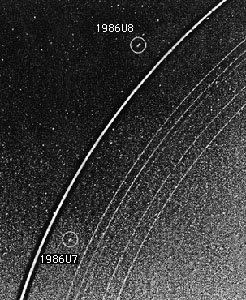
Collisions between the tightly packed ring particles would naturally lead to an increase in the radial width of the rings. Satellites more massive than the rings can halt this spreading in a process known as shepherding. At certain radii, termed resonances, in which the satellite's orbital period is a whole number ratio of the ring particles' orbital period, the satellite exerts a net torque on the ring by gravitational interaction. As the satellite and ring exchange angular momentum, energy is dissipated by collisions among the ring particles. The outcome of this interaction is that the satellite and ring repel each other. The one in the outer orbit moves outward, and the one in the inner orbit moves inward. Since the satellite is much more massive than the ring, it prevents the ring from spreading across the radius at which resonance occurs. A pair of satellites on either side of a ring can maintain its narrow width.

In the figure above, the inner two satellites of Uranus, Cordelia and Ophelia, orbit on either side of the Epsilon ring at exactly the right radii required for shepherding. Shepherds for the other rings have not been found, perhaps because the shepherds are too small to be seen in the Voyager images. Small moons may also be the reservoir that supplies the dust that leaves the ring system. Atmospheric drag is so large that the rings may be short-lived, in which case their origin and history are still unknown.
Excerpt from the Encyclopedia Britannica without permission.